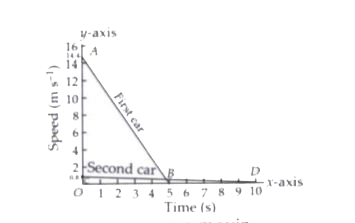A driver of a car travelling at 52 km applies the brakes and accelerates uniformly in the opposite direction. The car stops in 5 s. another driver going at 3 km in another car applies his brakes slowly and stops in 10 s. on the same graph paper plot the speed versus time graphs for the two cars. which of the two cars travelled farther farther after the brakes were applied ?
The data given in this numerical problem are in different units. So, we should first convert km unit into unit.
For first car:
Initial velocity
Final velocity, v=0 km
Time taken, t=5s
Initial velocity,
Final velocity,
Time taken, t=10s

The distance travelled by a moving body is given by the area under its speed-time graph. so, distance travelled by the first car=area of the triangle
Similarly,
distance travelled by the second car=area of triangle COD
Thus, the second car travels 4.1 m and the first car travels 36 m before coming to rest. so, the first car travelled farther after the brakes were applied.
Topper's Solved these Questions
- BOOK - MTG IIT JEE FOUNDATIONCHAPTER - MOTIONEXERCISE - Exercise (MCQ.s) Level-130videos
MOTION
- BOOK - MTG IIT JEE FOUNDATIONCHAPTER - MOTIONEXERCISE - Exercise (MCQ.s) Level-220videos
MOTION
- BOOK - MTG IIT JEE FOUNDATIONCHAPTER - MOTIONEXERCISE - Solved Examples25videos
MOTION
- BOOK - MTG IIT JEE FOUNDATIONCHAPTER - GRAVITATION EXERCISE - Olympiad/HOTS Corner20videos
GRAVITATION
- BOOK - MTG IIT JEE FOUNDATIONCHAPTER - SOUNDEXERCISE - Olympiad/HOTS Corner15videos
SOUND
Similar Questions
a driver of a car travelling at 52km/h applies the brakes and acceleration uniformly in the opposite direction. The car stops in 5s. Another driver going at 34km/h in another car applies his brakes slowly and stops in 10s. On the same graph paper, plot the speed versus time graphs for the two cars. Which of the two cars travelled farther after the brakes were applied ?
View SolutionA driver of a car A travelling at 54km/h applies the brakes and stops the car in 4 seconds. Another driver of car B travelling at 36km/h applies the brakes and stops the car in 6 seconds. Plot speed versus time graphs for the two car. which of the cars travelled farther before stopping ?
View Solution
Knowledge Check
- Question 1 - Select One
A car is travelling with a speed of 36 km/hr.The driver applies the brakes & retard the car uniformly.The car is stopped in 5 seconds. The retardation of the car
A2 m/s^2B3ms2C4ms2D6ms2 - Question 2 - Select One
When a car driver travelling at a speed of 10 m/s applies brakes and brings the car to rest in 20 s, then retardation will be :
A+2m/s2B−2m/s2C−0.5m/s2D+0.5m/s2 - Question 3 - Select One
What happens to the speed of a moving car when force is applied in the opposite
ASpeed increasesBSpeed decreasesCNo change in speedDChange in direction
The brakes applied to a car produce an acceleration of 6m/s2 in the opposite direction to the motion . If the car takes 2s to stop after the application of brakes , calculate the distance it travels during this time.
View SolutionThe brakes applied to a car produce an acceleration of 6m/s2 in the opposite direction to the motion . If the car takes 2s to stop after the application of brakes , calculate the distance it travels during this time.
View SolutionA car is traveling at 7.0 m/s when the driver applies the brakes. The car moves 1.5 m before it comes to a complete stop. It the car had been moving at 14 m/s, how far would it have continued to move after the brakes were applied ? Assume the braking force is constant .
View SolutionBy applying the brakes without causing skid, the driver of a car is able to stop his car with in a distance of 5m, if it is going at 36kmph. If the car were going at 72kmph. Using the same brakes, he can stop the car over a distance of
View SolutionWhen the driver of a fast moving car suddenly applies brakes, the passengers in the car
View Solution
